The book takes a case study, thematic approach that moves beyond buzzwords and industry jargon [thank goodness] to highlight emerging trends and best practices that are contributing to the future of business, society and culture.
I joined a group of folks that I admire including, Chris Anderson, Sarah Lacy, Robert Scoble, Jeremiah Owyang, Seth Godin, Dr. Natalie Petouhoff, Steve Rubel, Frank Speiser, among others.
I asked David if I could share our conversation as a book excerpt here and he obliged.
Enjoy…
What’s the Future of Business (#WTF)
Brian Solis is the closest thing that the new media and technology startup industry has to a rock star [I don’t know about that…I can think of people who are really rock stars, but thank you] —relentlessly speaking, author of several bestselling books, producer of Pivot, one of the industry’s most innovative conferences, advisor to hundreds of companies and global brands, and principal analyst at Altimeter Group, a leading firm focused on disruptive innovation.Highlights include:
• Why Experience Design is the next evolution of social
• The connected consumer and true digital convergence
• Why branding is more important now than ever before
• How constraint drives innovation, and why we should always be in perpetual startup mode
This entire interview focuses on the big picture. It starts with how social media disrupted business, and then moves to the next iteration of the social Web that Brian refers to as true digital convergence. Brian reminds us that there are always constraints on resources. True innovation requires creativity, vision, and empathy and is a way of life.
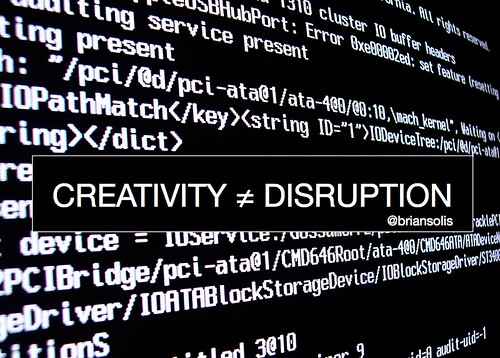
DP: I remember meeting you with a group of bloggers back in 2006 before social media was considered a formative field. You were one of the first people that I thought really “got it” in terms of understanding the revolutionary potential of these emerging communications platforms to change everything.
Was there an “a-ha” moment when you realized social media was going to be so big?
SOLIS: I’ve been working on this officially since 1997, when I created a new department within the marketing organization aimed at message boards, communities, and influencers. They were essentially the precedent of bloggers writing about trends, but using websites to create online magazines. I believed that this was the future of engagement, marketing, and services, and so I started a company in 1999 called FutureWorks dedicated to that practice i.e. the works of the future, sort of a lab but also an agency. I ran that company until 2011.
In those iterations, there were web 1.0, web 2.0 social media, etc. I always believed that the next thing was on the horizon, so I constantly reaffirmed my belief that it was OK to be in this perpetual startup mode. I always called that company a startup – whatever year we were in, it was a 7-year-old startup, a 10-year-old startup – because we were constantly experimenting and practicing new philosophies. We were adapting or inventing new business models along the way.
Even today, I still wouldn’t necessarily say that we are at that next big thing. Social media was one of those specs, those iterations—albeit, one of the bigger ones—but the next thing on the horizon is true digital convergence. That is what I’ve been focusing on with my last two books and my latest work with Altimeter Group.
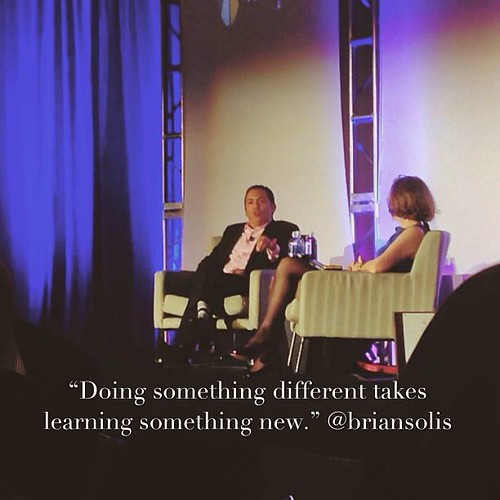
DP: Do you think we’ll still use the term social media in 5 or 10 years or is it the new norm now that we are moving to this era of digital convergence that you are talking about in your past two books?
SOLIS: That’s a really good question. I used to be a staunch defender of the term because it was much more than a classification. To me it was a representation of a shift in philosophy. Meaning that you’re not just creating, pushing and distributing media; you are sort of facilitating and democratizing it. That comes with a tremendous shift in the culture.
Five years from now, I could see us still using the term social media, though not as a classification but as a movement. For example, social media is sort of delivering this Undercover Boss moment to a lot of organizations, if you will, by allowing people to better see and reflect on the activities that are taking place outside the C-suite. It also humanizes the organization from the inside out so that it forces people to have conversations that they might not have otherwise had. That would be the context in which I see it being used. But from a technology standpoint we would have been deeply ingrained in this shift from social to digital convergence.

DP: I know in recent years there’s been a lot of focus on disruption, particularly among entrepreneurs and investors. Do you think this has changed the way people approach creating startups? For example, is there more emphasis on a quick exit and repeatable patters vs. trying to think really big and build the next Google?
SOLIS: Well, it’s almost a trick question. Disruptive technology and disruption overall is an effect of meaningful innovation. It means that it is already disrupting something. Entrepreneurs say that they are disrupting something as a form of aspiration, which is to some extent desensitizing or diluting the term and its importance. There are people who are becoming the next AirBnB for dog kennels. And then there are people focusing on true innovation. We see this in some of the most traditional industries going into biotech and green. If you look at Elon Musk, he disrupts anything that he touches. So I think it’s also a matter of your vision of creativity.
The word means innovation and that’s the word I think we need to consider more than disruption. At some point innovation could shift into disruption, but with disruption—this goes back to early economic theory, for example, creative destruction—something comes along and completely upsets the business model that exists only to be disrupted again with the next innovation. So it is a matter of focus, it’s a matter of state of mind. If you set out to disrupt something then you better disrupt it, but if you are saying you are going to disrupt it or that you are working on a disruptive technology, then you are fooling yourself and the people that are investing or trusting in you.

DP: That makes a lot of sense. I know that you work with a lot of advertisers and global brands. With social media, consumers are essentially involved in co-creating brands. What is the value of a brand and how do you help to define it if you have limited control over its creation?
SOLIS: I don’t believe you have limited control. I believe you have more control than you ever had before. I just think it is a matter of understanding what the word control means in this situation. Before, commanding control was “I speak, you listen” but the joke I used to tell everybody was that social media didn’t invent conversations or opinions. They have always been around. It’s just that now they are concentrated, searchable and indexable.
This becomes the future of branding in the sense that it is not just that they are co-created, but that they are concerted into a searchable collective. What I mean by that is if I go to Google and punch in key words, then you can’t control that moment of truth of what comes back. So what happens in a world where I ask somebody their thoughts, whether it is in a network or an app or I just review community exchanges? That’s a world that has completely been ignored up until now, and it is a world that’s been here since the Internet began, going back to the bulletin board system.
My point is that positive conditioning reinforces the types of conversations and exchanges that you want to have. Otherwise, you are just reacting to technology and you are reacting to impressions and experiences. The future of co-creation starts with the owner of the brand, meaning that I am defining what this brand means in today’s economy and what it means for you tomorrow from an aspirational standpoint.
It means that I have to put in a concentrated effort to define what it could be not just from an image standpoint, but from an emotional standpoint—what are you going to feel and what are you going to share?—because the future of co-creation has to do with shared experiences, not your ability to publish a thought but the experience that you have and share. Technology becomes an enabler to facilitate the positive conditioning of the experience you want people to have. That is why I talk about the future of branding as experience architecture. You define and strengthen it in every way and in every place possible.
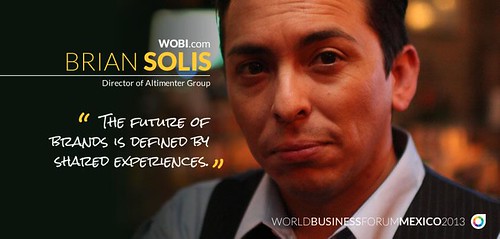
DP: In your latest book, you are championing a new movement that aligns user experience with innovation and leadership. How does providing experiences create real business value?
SOLIS: If you ask Apple what business they are in, they will tell you they are in the experience business. If you ask Colgate what business they are in they will tell you they are in the confidence business. If you ask Virgin what business they are in, they will tell you they are in the high roller jet set business.
It’s a matter of giving your customer something to align with, not something to transact with. You look at one of the brilliant aspects of the Apple Store and now the Tesla Store, it is not about products, right? It is about experience. The experience is sort of embodied in the product, but it is also embodied in interactions with the company. It’s a holistic thing. That is the value of experience.
You will pay a premium for an experience. Some studies show as high as 15% more for a similar product if you believe you are going to get a better experience with it. So the value becomes something bigger than just the widget. That changes the entire model for business—how you support and interact with customers, how you attract and keep them. And that to me is something a little bit more substantive, meaningful over time.
Think about the future of brands as a collective of shared experiences—there is this disconnect between what you think your brand is and the experience of your brand that people are sharing with one another. So your first step is to figure out how do you close that gap. Second is how do you meet it so you’re not reacting to it—essentially creating value through experience where UX [user-experience] almost becomes like a philosophy or a way of life, a way of business, not just a series of designs for products or screens.

DP: So experiences are essentially qualitative and yet without analysis there can’t be any really relevant insights. How do you use technology and data to optimize experiences and create feedback loops, and where does the human interaction element fit into that?
SOLIS: That’s what I talk about in terms of the human algorithm: it’s that intersection of data science and social science. I think one of the biggest ways to solve this is the balance of quant and qual, where you take the idea of a focus group—intentions, aspirations, etc.— and you solve them with data and a/b testing. The research starts with a hypothesis and then ends with a series of educated questions.
Even outside of this promise of what is possible, you don’t know what you don’t know and you don’t research what you can’t envision. This is why I think the future really comes down to digital anthropology. It’s just better understanding of behavior so that you can meet the needs and expectations of your target audiences before they actually show up as a data point, if that makes sense. That is where the human interaction element fits in, because otherwise you are trying to force people into a box.
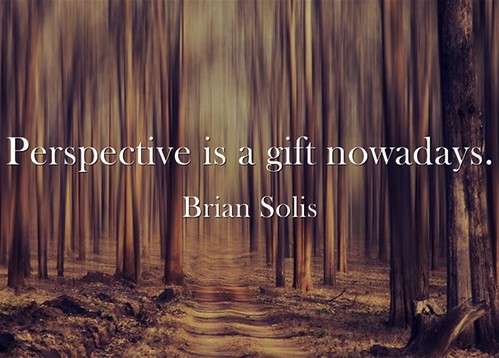
DP: I really like this especially—I was a former scholar of religion and culture before I got into social media.
SOLIS: Wow!
DP: I used to study the disruptive impact of the 60s impact and civil rights movements, so I looked a lot at grassroots protest and their use of new and emerging media—things like pamphlets and magazines and how they tried to culture jam and get pictures syndicated throughout the world to facilitate real meaningful changes.
I’m curious, in your latest book you referenced Joseph Campbell’s concept of the hero’s journey. What does it mean to go on a journey together with your consumers and basically evolve as a company focused on great customer experiences?
SOLIS: That’s a great question. Being a scholar and having studied religion and culture, you and I both know that the hero’s journey has deep roots in alternative religious aspects. I didn’t want to tackle that in the book (laughter). Most people actually believe—and I found this fascinating—that the hero’s journey aligns with popular culture (Star Wars and The Matrix) more than with actual religion. Academia really understands its true roots and I thought I would take a gamble to see if I could introduce it in a way that leaders could take at face value rather than try to unravel it.
In that regard, there are two journeys in the book. The first is this idea of digital ethnography and in all fairness you can’t unravel this. The hero’s journey shows you that someone really smart aligned mythology in religion to these certain paths that these characters seem to follow. The point was that it took research and it took someone really smart to draw the lines and draw a map. And you can do the same thing for your customer journey today. You can understand where they’re going, what is the context of what they’re trying to do, and what happens in each one of those stages.
The idea was just to align the digital ethnography to paint your own hero’s journey for your customer. Then, I wanted to inspire you to go along the journey with him or her to reduce the friction and create an ecosystem that was really special to be around before, during and after the transaction.
The second reference is the idea that it is not just about the customer and the journey you need to help and transform. It is also this idea the person within the organization who has to really think about its promise and opportunity is going to meet his or her own path of resistance. You too are going to have to be your own hero in the hero’s journey and that’s why I talk about the psychology of change at the end of the book. In sales, they sometimes refer to this type of person as an internal champion for the customer—the person that becomes the customer advocate within an organization.
You are going on this journey together—you and the customer—each with your own areas of resistance, so you need to know what you should expect to encounter so you can be empowered instead of delusional. You’re going to tackle something that is challenging but is also great, and what you’re about to take on is truly a hero’s journey: something that is bigger than you, something that’s bigger than the customer, because it is co-created. This is at the true heart of relationships and engagement, so you’re essentially changing business, the philosophy of business, in the process.

DP: We’ve heard the term Gen X and Gen Y. In your new book you give us the term Gen C or the connected consumer. So what is the connected consumer and how are they different from traditional consumers?
SOLIS: This is a big, big conversation. The easy answer is this—when we talk about Gen Y, Gen X and Gen Z, or Boomers and Millennials, we really tend to go down the demographic spiral. That limits our view of what is possible.
For example, you and I are both analog. We had to learn how to use digital in every iteration that has been thrown at us and they had to learn analog, which is crazy. And when you start to study behavior, you start to realize that older demographics, once they start using an iPad, a smartphone, or if they start getting a Facebook or Pinterest account, actually start to exhibit a lot of similar behaviors to Millennials. It’s fascinating. While it is not as extreme, there are similarities. This really introduces psychographics.
Talking about Gen C was my way of saying, “Stop looking at demographics and look at behavior.” Generation C is a collective of connected consumerism that just acts, thinks and influences differently than our traditional customer. It is a way to get people to see things differently, not by age but by their behavior.
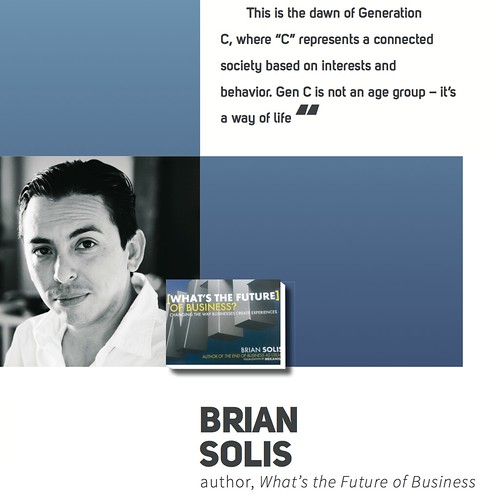
DP: Without awareness there can be no consideration. How does advertising factor into the whole equation and how do you think advertising has evolved since everything has become so social?
SOLIS: Traditional advertising still works. Don’t get me wrong. There’s a reason why the Super Bowl is amazing in terms of what a good creative spot will actually do. The way I look at the difference between the Super Bowl and everyday advertising is that they’re actually trying to make it a shared experience. They want you to feel it; they want you to talk about it. That to me is the premise of how advertising can be more meaningful. It is not just a creative idea: it comes back to good old-fashioned storytelling, if you will.
The evolution of advertising takes the storytelling format and gets it into the stream in a way that’s much more meaningful. This is why you see native advertising starting to take off, things like social networks, and different blogs starting to plug in in-stream advertising in the form of posts or sponsored posts. But they are all rooted in this idea of a journey. So it’s a story, a clickable journey that makes it a little bit more meaningful. I can’t just send you to a website because that will ruin the opportunity to capitalize on curiosity or an emotional connection we might have. I think awareness is a big deal but it’s just different. It’s much more thoughtful. We are already starting to see this happen today.

DP: Is what we’re saying here related to how the importance of the brand is really, really critical right now?
SOLIS: Yes, it’s more important than ever before. For example, I have a relationship with MTV. You and I probably used to watch music videos and that was what MTV meant to us. And then somewhere in our young adult life, it started to become a TV channel—things like The Real World. It would be videos and then programming, but today MTV is something completely different to the Millennial and to Gen C.
If you look at the relationship they have with MTV and even the relationships they have with artists, it’s no longer the idea of an artist taking on a meaning where I’m going to put posters on my wall because that artist signifies who I am and the artist becomes the avatar for that person. Instead, it’s this notion that the artist becomes part of who you are. You have a direct connection and can have meaningful exchanges across social platforms, which are integrated into your own network of relationships. It’s almost like a piece of your DNA, not your total DNA.
So the idea of a brand has to have an emotional connection that people will feel like you are part of them. This is why customer studies show that things like values, vision, and human empathy are becoming much more important triggers in terms of a brand relationship rather than sexiness or typical paid endorsements, and this is why—going back to your original question about social media—I believe that social media is going to have the true impact because the idea of becoming social means that you are by default becoming human.
The brand is more important than ever before because it’s going to make you re-think what your vision is, what your mission statement is, what your promise is. And then how do you bring that to life in everything you do inside and outside the company.

DP: You’ve advised over a thousand startups. As we were talking before you have essentially treated your own work as an evolving ongoing startup looking at the next big thing. How do you think startup culture has changed? How do you implement essentially a startup culture within an organization?
SOLIS: Startups back in Web 1.0 were really different. Technology was really new, it was really trying to find an early sense of mass appeal and just even the idea of a technology startup would get a lot of really creative funding. You really didn’t have to do much to get the attention of the world. In fact, you didn’t even have to do much to monetize.
Today, there’s still a sense of that legacy where your idea is great because it is your idea but I think the best businesses, the best startups, the best entrepreneurs are realizing that there is a mission to what they are trying to do and trying to solve for. There is a sense of purpose behind the startup and this constant growth hacking. Trying to solve for a problem using traditional means to do so only means that you have traditional outcomes.
So, what if you had to solve for something in a new way? I think the reality would be that you would find a new way. That to me is the source of the most successful startups and the most successful entrepreneurs. They are not satisfied because they are trying to disrupt something. They are not satisfied because they have series A or B funding and a valuation of a billion dollars. They are relentless in their pursuit of actually having an impact and measuring its impact in terms of permeation into a market.
That, to me is the true meaning of startup entrepreneurialism and growth hacking—the relationship between cause and effect and that—believe it or not—even as hot as startup technology is and startups in general are, and how important entrepreneurialism is to the American economy or even just the economy in general, it is still a rare trait amongst entrepreneurs: that true desire and passion to build something so meaningful that you never lose that core fire in everything that you’re trying to do because it becomes the impetus for how you make decisions moving forward.
Hopefully that made sense, because that for me is the spirit of entrepreneurialism in startups that gets missed out on in the allure of money, the lifestyle and publicity.

DP: Related to this idea of constraint, how does constraint relate to innovation?
SOLIS: There are so many catalysts for innovation, but I believe that constraint is the greatest. It’s also the one I mostly align with. I have never had resources. Even today, I don’t have the richest resources that allow me to do all the things that I have to do. Even with my latest book and all that I’m trying to do in my professional and personal life I still have to find creative solutions to do it.
I’m constantly innovating. Innovation, to me, is a way of life and it is not something that I see in a lot of entrepreneurs that I talk to. They are trying to build all-star advisory boards, trying to get celebrities to invest so they can align with names. They are trying to really hustle but I don’t know that they’re trying to innovate as much as they are trying to push. Swimming upstream isn’t the same thing as innovating.
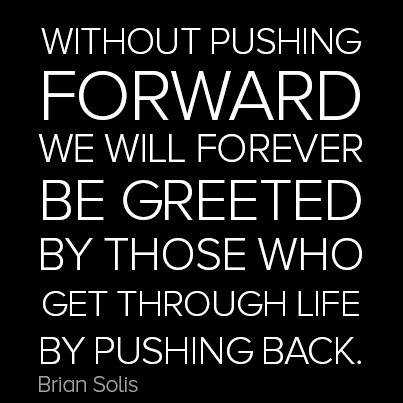
#DisruptorbeDisrupted

No hay comentarios.:
Publicar un comentario